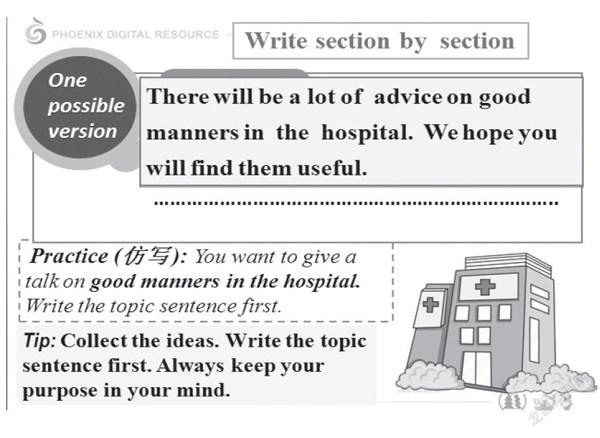基于微课的初中英语Task课型设计探究
陈国安






摘 要:英语写作能力的发展既是我国英语教育的重点,也是弱点,写作教学时常被异化为大量例文的背诵,背离了写作教学的宗旨。然而,随着现代教育技术的发展和教学资源的开发,英语教学有了多媒体手段、多平台以及多方位的空间。本文以一节初中Task微课设计为例,力求为教师提供可操作的写作课例。
关键词:基于微课、初中英语、Task课型、写作能力
学生英语写作能力的发展是我国英语教育的重点同时也是弱点。当前,我国中学英语写作教学时常被异化为大量例文的背诵,忽视了对学生写作过程的指导和训练。然而,现代英语教学有了多媒体的手段、多类型的平台和多方位空间的支持,特别是微课的兴起为我们的英语教学带来了全新的思路。教师要根据实际情况,积极学习设计微课,以帮助学生提高写作兴趣和能力。笔者以《牛津初中英语(8下)》Unit 5 Task 微课设计为例,探讨Task课型的设计,但愿能对大家有所启示。
一、教材分析
《牛津初中英语(8下)》Unit 5 的单元话题是“Good manners”, Task板块的标题是Table manners,该板块由三部分组成:(A)呈现一个关于“Good table manners”的演讲计划,作为学生拟定计划时的样稿,计划后另附useful expressions; (B)呈现学校网站上Amy和Daniel制作的一个短文填空形式的页面,要求学生根据计划完成短文;(C)和Task板块标题呼应,要求学生就一个方面的礼仪制订计划并创建自己的网页。显然,教材编写的意图是让学生先学习计划,提取有效信息完成教材范文的填空,在解读范文过程中了解范文的篇章结构和遣词造句,最后用所学礼仪的知识完成写作任务。
二、设计思路
微课的设计需要从微课类型、制作模式、微课长度、教学目标、内容、重难点等方面入手。
本课Task板块由A、B、C三个部分组成,循序渐进地强调了写作的前期准备(如选取标题、制订计划、收集信息等)到完成文章的过程活动,明确要求通过同伴互助、教师指导等活动完成写作任务。因而笔者选取了任务型教学法和过程写作教学法相结合的方法来设计本节微课,即写前(准备阶段)—写中(初稿—修改—校订—完稿)—写后(评价)。
该微课类型为“讲授”型,长度预设为8分钟,呈现形式为视听演示,故而选取了“录屏软件+PPT”的制作模式,微视频为MP4格式,设置片头及片尾,时间分别为片名字幕、片尾5″左右,片头出现1次执教者照片和简要介绍。
三、基本流程
(一)写前发展性铺垫
以Task板块A和B部分内容为依托,进行写前准备阶段的教学环节设计,激发学生写作兴趣,了解计划要素,把握报告整体框架,收集词汇,掌握写作微技能,选题拟订计划等。
1.观看录像,激趣导入
T:First of all, let’s watch a video. After watching, please answer the two questions: What are the three persons doing? Do the two men behave well?
【简析】播放一段三个英国人一块吃饭的视频,其中两个男士非常粗鲁,以至于女士忍无可忍,无奈离桌。西方餐桌礼仪视频的播放,很快把学生带入了话题情境,问题的提出引导学生进行讨论,激发了学习兴趣,导入新课。
2.头脑风暴,激活储备
T:The two men in the video don’t behave well. What should we do and what shouldn’t we do when eating or drinking? Please have a discussion in groups and share your ideas.
S:...(稍停顿)
T:What shouldn’t you do? ...
T:What should you do? ...
【简析】出具两个问题,拉幕式播放10张图片,目的是把图片和学生的生活体验相结合,从正面和反面讨论餐桌礼仪的有关注意事项,激活学生的知识储备。最后出具表格归纳好坏两方面的餐桌礼仪,将图片信息转换为文字信息,为后续写作收集素材。
3.依托教材,分析计划
T:The Class 2, Grade 8 students are giving a talk on good table manners. Read their plan and answer the following five questions. (What’s the name of the talk? What’s the purpose of the talk? When and where will they give the talk? What’s the content of the talk? Why should we know the rules?)
T:How many parts can we see? Yes, five.
【簡析】通过以上问题来分析突出计划表构成的Name, Purpose, Time and place, Content和Conclusion等关键要素,从而为后续制订计划做好铺垫。
4.提取信息,补全范文
T:Amy and Daniel are making a web page on the school website. Please help them complete their talk.
【简析】提取教材A部分的信息补全范文,使篇章完整。
5.分析范文,赏析词句
T:Find out the structure of the talk by reading. The key words may be of help.
T:Next let’s read the talk again to find out the useful expressions.
T We can take some expressions from their talk as examples when we are writing our own talk.
【简析】本环节旨在指导学生审视范文,确认段落结构以及段落大意,让学生加深对范文的理解,赏析范文的遣词造句,为后续写作做铺垫。
6.分段写作,各有侧重
T:Amy and Daniel’s talk gives us a good example for writing. Now let’s give our own talk. First of all, I will give you some tips. First, choose a topic as its name. Second, state the purpose directly and briefly in Paragraph 1. Third, state time and place properly.
T:Here is the practice for you. Never forget to imitate the expressions in Amy and Daniel’s talk. Suppose you’ll give a talk on manners in the hospital. Present the topic sentence first. 展示:
T:We have written the topic sentence and next we will give supporting details. Also, I will first of all give you some tips. You should list the supporting details and make sure every sentence after the topic sentence should support it.
Here’s the practice. Suppose you want to give a talk on good manners on the street. Choose the supporting details. 展示:
T:The third tip is that, use linking words and phrases to help the reader better understand the relationship between ideas when writing the supporting details.
T:Now it’s time for practice. Please give a talk on manners in the library. Present the supporting details. 展示:
T:Let’s move to the last paragraph, the conclusion part. In Paragraph 4, restate the talk’s main points.
T:Now let’s have a try. Suppose you’ll give a talk on manners in the park. Please draw a conclusion. 展示:
【簡析】本部分通过逐段分析教材范文,让学生明晰每段的写作侧重点,拓展了学生思维,帮他们理清了思路。六个不同场合礼仪信息的针对性小练习,形式多样,写作视角开阔,从多个角度对学生的写作思维和技能进行了训练,学生的写作水平得到有效提高。
此外,我们还可以通过鼓励学生用多种方式来表达,以提高学生的遣词造句能力。通过讨论,半开放或开放式制订写作计划,通过展示计划来帮助学生查找计划要素是否缺失,支撑素材是否有效。
以上这些环节的设计在写作微技能指导方面做了有益的探索。 设计的针对性微型写作练习,给学生提供了形式多样的有效语言输入和范例,从不同角度训练并培养学生的写作思维和技能。学生从独立思考到积极参与,形成了思想与方法的发展性建构(皱国香,魏玉平 2015)。已有知识的激活和大量信息的输入,为学生生成性输出做了有效铺垫。
(二)写中生成性输出
继续以过程取向写作教学模式作为指导思想,将初稿(Draft)—修改(Revise)—校订(Edit)—完稿(Publish)和Task板块C部分内容有机结合,教给学生写作方法,帮助学生理解和内化写作全过程。此部分要给学生预留足够的时间,学生活动的形式可以灵活多样。为走出教师重结果轻过程,对初稿的示范修正一带而过,学生的互评流于形式,写作教学异化为例文的背诵等写作教学误区。笔者在设计本节微课时做了大胆的探索。
1.当堂训练,完成初稿
T:Now write your first draft with a complete structure, clear and effective ideas and rich expressions. Having a look at the outline of the talk will be helpful.
Now talk in pairs and then complete the draft on your own.
2.修正示范,自纠错误
T:Please improve your writing after you finish the draft. Look at the following draft. How can you revise your writing? You should focus on the overall flow of the talk, especially the structure, main points and details. Circle any mistakes you notice but focus on the big problems. You can use move、cut or add while doing the revision.
Look here, we can use move parts to the right place, cut out unnecessary details and add new materials to make our writing better. They are good ways, do you think so? Now revise your writing on your own. 展示:
【簡析】教师示范初稿修订,具体指导学生自评,使学生从篇章结构上把握写作方法。
3.同伴合作,校订错误
T:Boys and girls, have you improved your writings greatly? What should you do next? Read your writing more slowly and carefully to find out other mistakes in grammar, clearness, punctuation, spelling and capitalization. Please follow the four steps and edit your writings with your parters. 展示:
【简析】通过示范初稿的校订,具体指导学生同伴互评,让学生在小错纠正中不断改善并提高习作水平。
4.注意书写,完善二稿
T:Now we’ll come to the final copy. Please make your own web page with your best handwriting. Try to make your web page more beautiful.
写前—初稿—修改—校订—完稿,这五个写作步骤各有侧重,层次清晰,环环相扣,一气呵成,学生习作的输出水到渠成。这五个写作步骤是本节课的又一个教学重难点。在设计习作修改环节上,笔者努力避免流于形式,让教师有实际操作的抓手。
此外,我们可以通过写后评价性展示,让学生在多层评价中进一步发现问题,享受成功。通过课堂总结,巩固已学知识,讨论礼仪,进行情感升华。
四、反思与展望
本节Task微课,笔者力求为教师提供可操作的课例。在设计过程中,能充分把握Task课型的特征,既关注了教师教的层面,又关注了语言学习的规律,并且符合学生的心理认知特点。特别对平时教学中遇到的写作微技能指导和习作修改的瓶颈问题做了有益的探索,力求为学生提供翔实有效的写作指导。然而,Task课型的微课设计没有固定的模式,需要我们在工作中进一步加深对于微课的理解和认识,进一步熟练运用现代教育技术手段,积极探索,不断前行。
参考文献
[1]皱国香,魏玉平.例析中学英语读写训练中的铺垫与生成[J].教学月刊(中学版),2015(Z1):76-79.
[2]何美红.基于微课的初中英语“过程写作”教学的思考与实践[J].江苏教育研究,2015(02):54-57.

